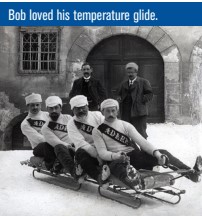The two most recent columns in this series may have seemed unnecessarily gloomy about zeotropic refrigerant blends. However, like most things in life that have unusual features, there are ways in which their oddities can be used to advantage.
A zeotrope is a blend of refrigerant fluids with different boiling points which behaves normally. In abnormal blends, also known as azeotropes, the components of the blend interfere with each other and the mixture behaves as if it were a single fluid with the various components boiling in proportion to the original composition. The ingredients of zeotropes (the normal ones) don’t interfere with each other. This results in one of two things, depending on the circumstances.
If the refrigerant is evaporated inside a tube during a flow process then the pressure will be relatively constant, subject only to the usual pressure drop required to create the flow. The boiling temperature will drift as the more volatile component of the blend boils more enthusiastically than its less vigorous companion, changing the composition of the liquid flow. This distillation is not a problem for the compressor provided the liquid is completely evaporated before it leaves the tube since the composition of the dry gas will be the same as the liquid inlet. Trouble comes if the liquid is not completely evaporated, which can happen if the control system regulating the flow through the expansion valve doesn’t take account of the shift in boiling temperature of the liquid.
When the liquid is in a pool and is boiling (imaginatively called “pool boiling”) the situation is different. The more volatile component (the one which boils more easily—recognized as the one with the lower boiling temperature for a given pressure) will evaporate first, leaving the
less volatile component behind. This is the well-understood, time-honored process used in whisky distillation to separate alcohol (more volatile) from water (less volatile) in order to strengthen fermented liquor. When used in refrigeration systems it’s troublesome because the composition of the gas flowing through the compressor is now different from the composition in the evaporator.
The change in boiling point is known as “temperature glide” and the change in proportion of the components is called “composition shift.” These are the oddities that can be turned to advantages when a zeotrope is used. If a fluid is being cooled through a large temperature range, for example chilled water for a production process, then the temperature glide can enable the compressor to run with a higher inlet pressure than would otherwise be possible. This is only possible if the fluid flow directions on either side of the evaporator can be arranged suitably. Unfortunately this can sometimes make the evaporator more expensive, so there is a capital cost versus operating cost trade-off to be considered.
In more extreme cases a single circuit system with a far higher range of boiling points could be used instead of a cascade plant to reach very low temperatures. This is known as an “auto-cascade.” Where there is a wide range in air temperature, for example along the product path
in an in-line tunnel freezer, a similar technique could be used. As far as I am aware, this approach has not been commercialized, perhaps because the glide in commercially available zeotropes is not large enough to be worth it.

